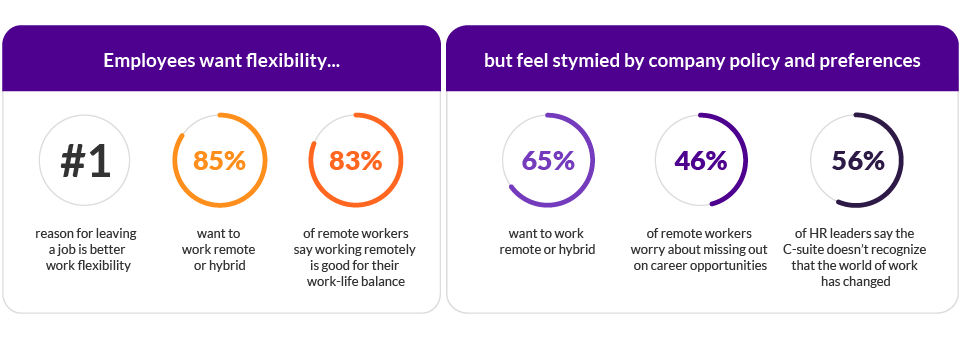Create a culture that means business™
Email address
The world of work has changed. This may seem like an obvious statement after more than two years of working through a pandemic, an unprecedented resignation wave, and a looming recession. However, according to HR, more than half of company leaders don’t understand that organizations must change how they attract and retain employees to remain competitive.
56% of HR executives say their company leaders don’t appreciate that the world of work has changed.
Employees want flexibility
The number one reason for changing jobs during the pandemic was for greater work flexibility, beating out both career progression and compensation. Employees are no longer willing to compromise on flexibility at work, and companies with a hardline return to office policy will lose out on top talent.
Most employees (85%) who have the option would like to work remote or hybrid. However, two-thirds say company leaders expect them in the office at least part-time and 46% of remote workers worry about missing out on career opportunities.
Resisting the new world of work
Unfortunately, almost half of HR leaders say they do not have the support they need from the C-suite to implement policies to attract, engage, and retain top talent. More than half say the C-suite doesn’t understand that the world of work has changed. At companies where HR leaders say the C-suite is supportive of remote work, they are less likely to say they struggle to attract and retain. This shows the direct connection between remote work and recruiting top talent.
Companies where senior leaders are accepting of remote work are 29% less likely to struggle with attraction and retention.
At the precise moment that we are experiencing record-high resignation, and bracing for a recession, employees are telling us what they need — flexibility. It’s time for leaders to understand what flexibility means and to put the conditions in place for employees to stay and do the best work of their lives.
As HR leaders look to gain buy-in for this transformation, it’s important to identify the potential concerns executives are voicing around shifting to a flexible or even fully remote work structure.
A top priority of organizational leaders is to ensure employees are engaged, connected, and collaborating but many feel unsure about how to achieve this without regular in-person interaction. Yet most employees, the very people who wish to feel engaged, connected, and collaborative, are clearly communicating that they do not need to be in the office to achieve this type of employee experience.
The key to fostering a rich experience of connection at work without a traditional structure is the implementation of thoughtful processes and technology that builds an experience of trust and belonging.
What can HR leaders do about this challenge?
1. Get buy-in with data
Senior leaders want more than intuition and instincts — they’re looking for hard data to prove specific trends. Use the data in the Tech-Enabled Employee Experience Report to demonstrate to senior leaders that the world of work has changed and they need to evolve their strategies to remain competitive.
2. Gather employee input
No one knows what your employees want and need better than your employees themselves. Survey your workers to find out what their work priorities are so you’re making decisions based on data that is specific to your organization. Gathering and taking action on feedback is one of the most important ways to drive employee engagement and commitment.
3. Develop a plan
Once you know what your employees need, consider what your organization needs. Finding alignment between these two areas will be key to finding solutions that work company wide. Look for opportunities to add flexibility to your employees’ work life.
4. Execute and communicate
Once you have your plan in place it’s time to put it into action. Ensure you are communicating frequently and effectively with affected employees. The Achievers Workforce Institute Wellbeing Report found a significant disconnect between HR and employees when reporting on programs offered. The way to close this disconnect is 1) getting employee input on programs and 2) ample communication about new and ongoing initiatives.
5. Continuous listening and iteration
Finally, keep in mind that few programs are “set it and forget it”. Continue to seek feedback on the policies and initiatives you put in place and iterate on those programs to ensure continual improvement.
Organizations that recognize the change in the world, gather feedback from employees on their wants and needs, and take action based on that feedback will adapt and thrive in the new world of work. HR leaders must be the visionaries in their organization to show the way forward and win buy-in from senior leaders.
Read the Tech-Enabled Employee Experience report, available now.



